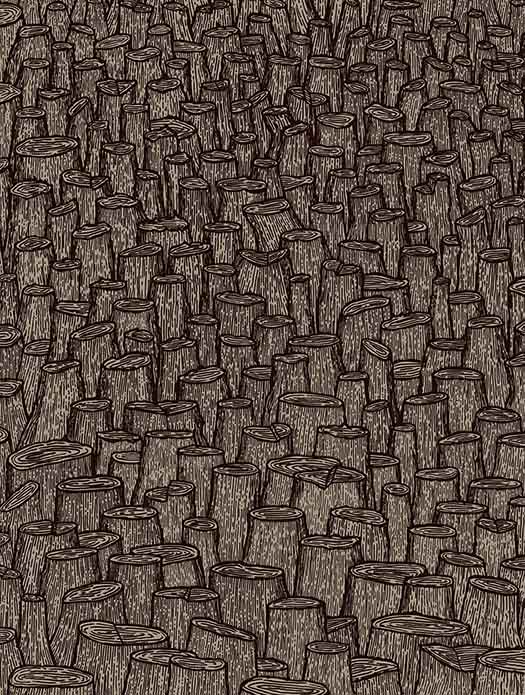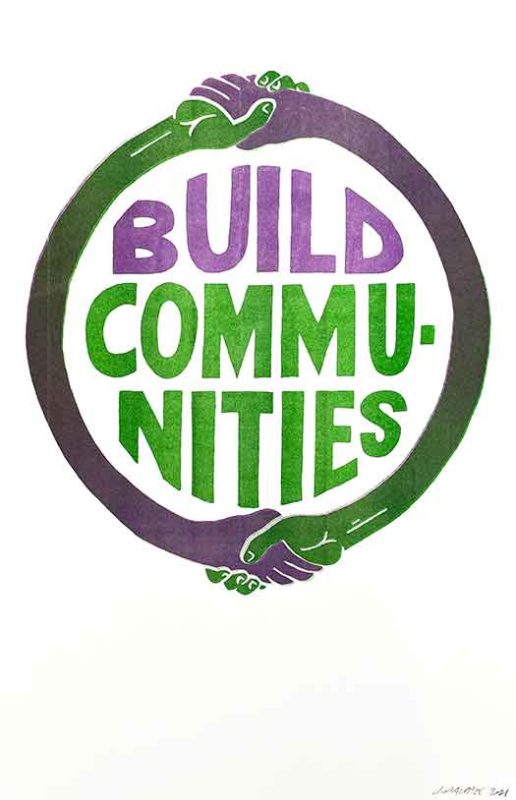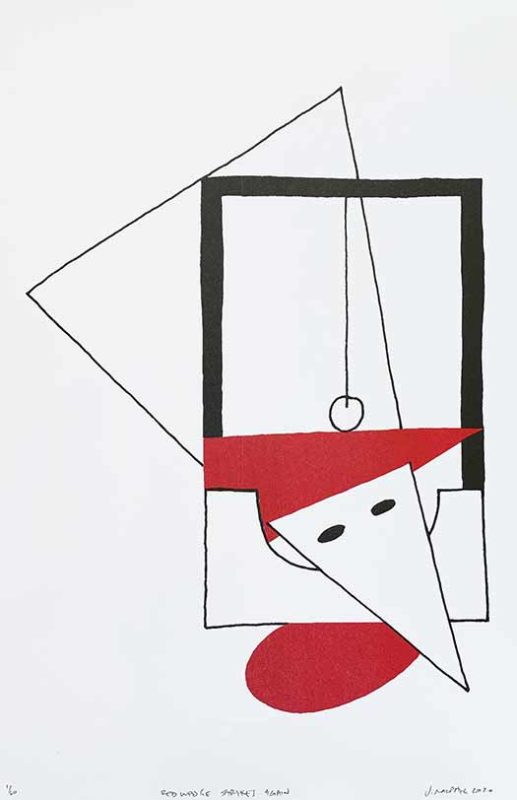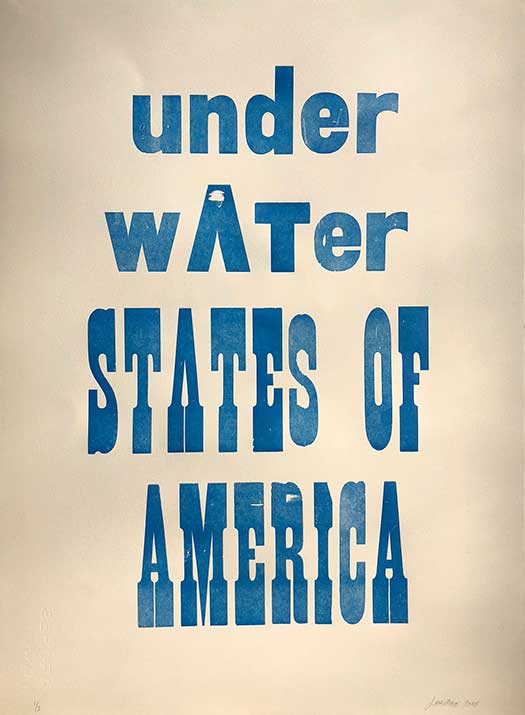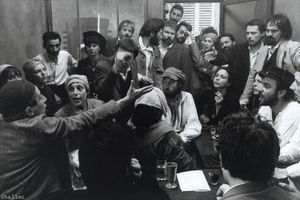
Peter Watkins is one of the more interesting antiauthoritarian political filmmakers of the last 40 years, and his most recent film, La Commune, is screening this Saturday at 16Beaver in NYC. This is a rare opportunity to watch this film as intended: all at once (it’s long!) and with a group, with discussion to during and after, and over a meal! Here’s the details:
What: Screening, Discussion, and Dinner
Where: 16Beaver Street, 4th Floor
When: Saturday 07.17.10 at 11:30 am
Who: Free and open to all
This Saturday we will screen and discuss a film that has been an open secret for almost the past decade. As a filmmaking model, experimental social process, and work of radical history conjoined to media critique, it has remained an important work for many of us who have had the opportunity to see it at past screenings or since the 2006 DVD release. When we write “work,” we do not mean to reduce the authorship of this project to Peter Watkins alone, as the most remarkable aspect of the film is the extent to which its participants’ interactions extend beyond the production process. It is a film with a “plus,” an outside. While it bears stylistic resemblance to much of Watkins’ work, it is this difference that most interests us at 16Beaver. Following Marx, if we cannot yet achieve on Saturday the ultimate stage of Communism, where the state withers away, we can at least witness a film where the director as master or authority withers away in favor of a group of participants/co-researchers/co-thinkers (not merely actors reciting lines or hitting marks) who come to take responsibility for their own representation.
We offer La Commune on Saturday a work of such importance, and hope this event will depart from past public screenings in NYC in viewing and discussing the work collectively along the lines Watkins and the group Rebond Pour La Commune have attempted to facilitate since its release. Perhaps the only reason we have not held a full-length screening and discussion sooner is a daunting question regarding how to situate an event appropriate for this monumental work. Respectfully, we also wish to
question the role of a such a model, as well as the claims on its behalf (see below), in the direct present by thinking through the decade history that has come to pass since La Commune was shot in 1999. There is much to say in this regard, but perhaps we can gesture to one parallel history where 1999 points to the WTO resistance in Seattle (the subject of its own flop Hollywood feature) a nascent alter-globalization movement, and the beginning of Indymedia. The spirit of this history of protest and independent media, in Commune TV, flows through the most anachronistic
moments in La Commune. If we locate this energy in a moment now ten
years past, not to mention all that has come between, we would be right to question what the film can tell us about creating openings and possibilities for resistance and social revolution today.
With the exception of the summer reading group, this is our first event at
16Beaver since the US Social Forum and we hope that the spirit of that
gathering, as well as La Commune’s complementary efforts toward
involvement, will infuse our time together Saturday. 16Beaver as an
ongoing public platform traverses this time, from 1999 to the present, and
as we attempt to formulate collective strategies for surviving the present
there is much in “La Commune” that may feel familiar around sharing time
and committing to a group process of dialogue and discussion. The question
of time returns to us in the form of discussions of the fragmentation of
contemporary work and life (as if they are separable), as well as the
drive under late capital toward quantification and measurement in all
interactions and social activity, even as our lives grow increasingly
fragmented and psychically exhausting. If the distance between 1999 and
now has seen an intensification of the media effects that Watkins
positions himself in opposition to, and we might take these questions of
duration, and time, and ask how they might translate today, not just in
relationship to engaged forms of media production, but to our lives
outside the screening room. “La Commune” is rare; its duration feels hours
shorter than it actually is, its Brechtian traits ultimately structuring
an impassioned, gripping, fierce project. We hope you’ll join us.
“La Commune: Paris, 1871” (Watkins, 2000, 345mins, DVD)
For this day-long screening, we will divide the film into two parts, with
a 30 minute break in between. The screening will begin at 11:30am.
Following the film, there will be a light meal.
This screening is co-organized with Doctruck, Red Channels, and Brecht Forum
___________________________________________________
2. About “La Commune: Paris, 1871″
‘La Commune” was shot in 1999 entirely in an abandoned factory in
Montreuil, a Paris suburb, dressed to suggest the streets of the
working-class 11th Arrondissement and populated by some 220 amateur and
professional actors. Mr. Watkins involved his cast in doing their own
research on the characters, actual or composite, they would be playing.
The performers then had to divide into groups representing the conflicting
factions in the drama: members of the National Guard, who deserted the
government to support the Commune; the neighborhood politicians, who rose
to prominence as the Commune became more centralized and authoritarian;
the bourgeoisie (curiously, most represented by angry, umbrella-wielding
women), who opposed the Commune; and the oppressed populace of
seamstresses, laundresses and artisans, the Commune’s most passionate
participants.
La Commune: Paris, 1871 (Watkins, 2000, 345mins, DVD) is one of Peter
Watkins most assertive measures against Monoform,* methods of media
production and distribution. It is an event, a collaboration, and a
beseeching — a warm, crafty endurance that produces questions like weeds
throughout its nearly six hour run time. Length is only the most discussed
abbererant feature of LA COMMUNE, and perhaps the least interesting.
Watkins employed techniques in casting, research, shooting, and editing
that address form and delivery in radical ways, many of which surface in
his work, but are taken to a deliberately lengthy extent here.
*The MONOFORM is the internal language-form (editing, narrative structure,
etc.) used by TV and the commercial cinema to present their messages. It
is the densely packed and rapidly edited barrage of images and sounds, the
‘seamless’ yet fragmented modular structure which we all know so well.
This language-form appeared early on in the cinema, with the work of
pioneers such as D.W.Griffith, and others who developed techniques of
rapid editing, montage, parallel action, cutting between long shots/close
shots, etc. Now it also includes dense layers of music, voice and sound
effects, abrupt cutting for shock effect, emotion-arousing music
saturating every scene, rhythmic dialogue patterns, and endlessly moving
cameras.
http://pwatkins.mnsi.net/hollywood.htm
DVDs of LA COMMUNE are available from Icarus Films
http://icarusfilms.com/new2002/la.html
Thanks to Jonathan Miller at Icarus for supporting this community screening.
___________________________________________________
3. About Dinner
Please bring something to share during the break coffee/tea/juice or your
favorite sticky summer fruit or can-be-eaten raw vegetable. OR please
bring something to contribute to the dinner where we will provide a salad,
cheese, bread, and wine (note: more wine/bread/salad/cheese always
welcome). Please bring less sugar-based foods and less-industrially
processed/produced food.
___________________________________________________
4. “La Commune” by Peter Watkins
from http://pwatkins.mnsi.net/commune.htm
Why this film, at this time?
We are now moving through a very bleak period in human history – where the
conjunction of Post Modernist cynicism (eliminating humanistic and
critical thinking in the education system), sheer greed engendered by the
consumer society sweeping many people under its wing, human, economic and
environmental catastrophe in the form of globalization, massively
increased suffering and exploitation of the people of the so-called Third
World, as well as the mind-numbing conformity and standardization caused
by the systematic audiovisualization of the planet have synergistically
created a world where ethics, morality, human collectivity, and commitment
(except to opportunism) are considered “old fashioned.” Where excess and
economic exploitation have become the norm – to be taught even to
children. In such a world as this, what happened in Paris in the spring of
1871 represented (and still represents) the idea of commitment to a
struggle for a better world, and of the need for some form of collective
social Utopia – which WE now need as desperately as dying people need
plasma. The notion of a film showing this commitment was thus born.
Production background
In February 1998 I met with Paul Saadoun of 13 Production, a documentary
film company based in Marseilles, and we agreed to produce a film on the
Paris Commune. During sixteen months of intensive research and
pre-production, with the exception of La Sept ARTE in France, all of the
major global TV associations which were approached, refused to participate
in funding for the film. “I do not like Peter Watkins’ films,” said the
Commissioning Editor for the BBC in London. Early in 1999, one of the
major art centres in Paris – the Musée d’Orsay – learned of our film,
decided to organize an exhibition on the Paris Commune (consisting of
contemporary photographs, and the works of Corbet, a member of the
Commune), and allocated 300,000 francs to our film budget. It is
interesting in this context to note that cultural institutions, museums,
and art galleries are beginning to fill the vacuum left by the
increasingly conservative MAVM, which has all but ceased to produce
serious works for the mass market!
The filming of ‘La Commune’ took place in July 1999, in an abandoned
factory in Montreuil, on the eastern edge of Paris. The factory stands on
the site of the former film studios of French film pioneer Georges Méliès
(1861-1938). Méliès, who died in poverty, discovered and exploited many of
the basic camera tricks used in the cinema: stop motion, slow motion,
dissolve, fade-out, superimposition, and double exposure. From 1899 to
1912 he produced more than 400 films, the best of which combine illusion,
comic burlesque, and pantomime – treating themes of fantasy in a playful
and absurd fashion. Méliès’ films include ‘Cleopatra’ and ‘Christ Walking
on the Waters’ (1899), ‘A Trip to the Moon’ (1902), and ‘Voyage Across the
Impossible’ (1904). Given the nature of our own film, it is interesting to
note that Georges Méliès also filmed studio reconstructions of news events
– an early type of newsreel. The factory which was built on the site of
the Méliès studios recently became a performance venue for the theatre
group ‘La Parole errante’, which, under the administration of Jean-Jacques
Hocquard, is based around the work of dramatist, poet and director Armand
Gatti.
Working with Agathe Bluysen, one of our main researchers, and our casting
crew – principally my elder son Patrick, and Virginie Guibbaud – I
enlisted over 220 people from Paris and the provinces to take part in the
film; approximately 60% of them had no prior acting experience. Among the
cast were a number of people from Picardy and other regions of France,
with specific dialects and accents (since many migrants from the provinces
took an active role in the Commune). Through the conservative press in
Versailles, and newspapers like Le Figaro, we also recruited people from
the Paris area to join the project specifically because of their
conservative politics (to act in roles opposed to the Commune).
The set in the disused factory was designed and constructed by Patrice Le
Turcq as a series of interconnecting rooms and spaces, designed to
represent the working class 11th district of Paris, a centre of
revolutionary activity during the Commune. The set was carefully designed
to ‘hover’ between reality and theatricality, with careful and loving
detail applied for example to the texture of the walls, but with the edges
of the set always visible, and with the ‘exteriors’ – the Rue Popincourt
and the central Place Voltaire – clearly seen for what they are –
artificial elements within an interior space.
Cinematographer Odd Geir Saether filmed ‘Edvard Munch’ in 1973. To
implement my plan in ‘La Commune’ for long, highly mobile uninterrupted
takes, Saether and chief lighting technician Clarisse Gatti covered the
ceiling of the factory with regularly spaced special neon lights, to give
an even luminescence to the whole area, and to prevent the use of
traditional lights on the floor obstructing the path of the hand-held
camera. Jean-François Priester developed an equally ingenious method for
the highly mobile and flexible recording of the sound, using two boom
operators with radio-microphones and portable mixing system, which moved
around the labyrinthine set.
Filming ‘La Commune’ – before, during, and after
Elsewhere in this website I have written about the need for the
contemporary MAVM to work with alternative forms and processes, to search
for less hierarchical ways of communicating with the public. I would like
to briefly describe how we tried to achieve this in ‘La Commune’, with the
hope that the ideas will help to animate other alternative uses of film
and TV, in an attempt to challenge the Monoform structure and its
accompanying problems. Broadly speaking, our ‘process’ manifests in the
extended way in which we involved the cast in the preparation for, and
then during the filming, and in the way that some of the people continued
the process after the filming was completed. Our ‘form’ is visible in the
long sequences and in the extended length of the film which emerged during
the editing. What is significant, and I believe very important in ‘La
Commune’, is that the boundaries between ‘form’ and ‘process’ blur
together, i.e., the form enables the process to take place – but without
the process the form in itself is meaningless.
Before the filming we asked the cast to do their own research on this
event in French history. The Paris Commune has always been severely
marginalized by the French education system, despite – or perhaps because
of – the fact that it is a key event in the history of the European
working class, and when we first met, most of the cast admitted that they
knew little or nothing about the subject. It was very important that the
people become directly involved in our research on the Paris Commune,
thereby gaining an experiential process in analyzing those aspects of the
current French system which are failing in their responsibility to provide
citizens with a truly democratic and participatory process. The French
education system is definitely one aspect which is not functioning in this
regard; its marginalization of the Paris Commune is only one part of a
bigger problem – which includes an almost complete absence of critical
media education.
The cast research on the Paris Commune in the months prior to the filming
supplemented over a year of intensive investigation by our own research
team (led by Agathe Bluysen and Marie-José Godin, with Laurent Colantonio,
Stéphanie Lataste and Laure Cochener, and working with such eminent
historians as Alain Dalotel, Michel Cordillot, Marcel Cerf, Robert Tombs
and Jacques Rougerie). Our work necessitated a very broad and at the same
time detailed sweep through dozens of different aspects of the Paris
Commune and of this historical period in France – ranging from the
personalities of the Commune and the Versaillais government, debates in
the Hôtel de Ville and in the National Assembly, the role of women and of
the Catholic Church and its education system, the problems of sewerage,
drinking water and lighting in Paris, military uniforms of the period,
music and songs of the period, etc. etc.
At a later stage, the research work involved the actors forming groups
(e.g., those playing the Union des femmes; the bourgeoisie opposed to the
Commune; the soldiers of the National Guard; the officers and men of the
Versaillais forces; the elected members of the Commune, etc.) to discuss
the background of the people they were portraying, as well as to reflect
on the links between the events of the Commune and society today. In this
way, we were asking the cast to contribute directly to the manner of
telling their own history – as opposed to the usual hierarchical and
simplistic process of TV and filmmaking. This is a central part of the
process of our film.
During the filming the cast were also engaged in a collective experience,
constantly discussing – between themselves, and with myself and members of
the team led by Agathe Bluysen – what they would say, how they might feel,
and how they would react to the events of the Commune which were about to
be filmed. Simultaneously, Marie-José Godin was preparing the young and
older women who played the girls in the Catholic school in the rue
Oberkampf and their supervising Sisters, and the two Catholic priests. The
results of all of these discussions were then placed – or emerged
spontaneously – within the scenes which were filmed in long, uninterrupted
sequences, following the chronological order of the events of the Commune.
Most of the cast really liked this method of filming, for they found that
it offered much more continuity of experience than the usual fragmented
practice of filming short, disconnected scenes. Many of the people felt
this whole process to be exciting and stimulating, quite unlike the
preplanned and prescripted manner of making most films. This process also
enabled the cast to improvise, change their minds, relate to each other in
actual discussions during the filming, etc. Many found this filming method
to be dynamic and experiential, for it forced them to abandon pose and
artifice, and led to an immediate self-questioning on contemporary society
– which they had to confront on the spot.
There are also a number of scenes in the film in which the FORM was
entirely different again: when the camera is static (except for a few
gentle moves left or right), i.e., when it covers extensive discussions
among various groupings of Communards – during which time the cast speak
with each other (with no intervention by myself or the TV Communale) –
recorded non-stop, sometimes for up to 30 minutes (the only pause being to
change the magazine in the camera). These scenes occur for example when
the women of the U.D.F. speak in the cafe, first about organizing as if in
1871, and then about conditions for women today, and when the National
Guard heatedly discuss the pros and cons of centralizing decision-making
during a revolution.
In both the ‘static’ discussion scenes and in the mobile sequences, people
are rarely, if ever, framed in close-up as individuals – usually there are
at least two or three people in the frame at the same time. This, and the
manner in which people speak with each other, allows for a group dynamic
which is very rare in the media today.
After the filming of ‘La Commune’ (as a result of their intensely
collective experience), a number of the cast continued to meet regularly
over the following months, to socialize and to exchange ideas. Cast actor,
painter and pedagogue Jean Marc Gauthier developed the idea of forming a
non-hierarchical association called Le Rebond pour la Commune, to continue
the work begun with the film – to expand on its ideas and its critical
debate vis-à-vis society.
In March of this year, Le Rebond organized a weekend of public talks in
Montreuil, with ca. 300 people attending presentations and discussions on
the role of women, the media, work, power, and other key themes. Woven
through the events of the weekend were debates on the Paris Commune – a
direct link from the present to the past. Le Rebond is undoubtedly the
most important ongoing development in the process of any film I have made,
and shows that it is entirely possible to create processes within the
audiovisual media which can move beyond the limitations of the rectangular
frame.
[snip]
continue reading at:
http://pwatkins.mnsi.net/commune.htm
___________________________________________________
5. About Rebond pour La Commune
[Rebond pour La Commune grew out of participants’ desire to distribute and
discuss the film after it was initially buried by the european television
network ARTE and other distributors]
http://www.rebond.org/english.htm
An Association for the promotion and distribution of ” La Commune.”
Seeing the difficulties which a film of such scope encounters : the
insidious censoring by ARTE on TV and their refusal to distribute the film
on video, the marginalizing of the work, the refusal of French film
distributers to release the film, the silence in the media… This asks
questions of our capacity to prolong and develop the process of resistance
and participation.
This is why our Association also sets itself the objective of developing
communal experience by the creation of places and spaces where discussions
which propose thought, reflection, and organization against the abuse of
power by the dominant mass media can take place. To initiate, propose and
organize collective projects and debates around the questions which ” La
Commune (Paris 1871) ” raises for us. To create free speech, with or
without the institutions … A ‘wide-angle’ vision rather than
‘tele-objective’.”
___________________________________________________
6. “… beyond the limitations of the rectangular frame” — Michaela Poschl
“… beyond the limitations of the rectangular frame” La Commune, DV, 345
Min., Peter Watkins, 1999
by Michaela Pöschl, translated by Aileen Derieg
Originally appeared on:
http://eipcp.net/transversal/1003/poeschl/en
La Commune. Paris 1871 is described as an “UFO in the audiovisual
landscape”[1], a film that “falls out of the frame”. The subject matter:
the workers’ revolution of 1871 in Paris ending with a bloodbath – 30,000
Communards dead.[2] The title of my essay quotes the director Peter
Watkins. He describes La Commune as a process moving outside the
boundaries of the framework – in film language: the frame. How does La
Commune show the actions of a crowd, how does the film give this crowd of
workers a form, and how is taking action (reflection and action) possible
beyond this representation? Watkins’ question and mine as well is: Can the
principles of collectivity and self-organization, but also the
contradictoriness of the Commune be suitably represented? A film grew out
of this question about suitable representation, which leaves behind the
traditional framework of production and reception at three levels: at the
level of form, at the level of the production process, and at the level of
distribution and presentation.
I.
La Commune was supported by Arte and the Paris Musee d’Orsay. Although it
was originally planned to produce a 35 mm version from the 16 mm negative
for the cinema, there was not enough money to do so, because Arte did not
uphold the agreement to release and distribute a video edition, and the
film, being 345 minutes long, found neither producer nor distributor. The
film was shot in an empty factory building in June 1999 over 13 days,
following the chronological sequence of events. Neon lights were mounted
on the ceiling of the building providing even lighting. This made lamps on
the floor superfluous, camera and sound technicians could move freely
through the crowd. The set, a series of interconnecting spaces, represents
the 11th Arrondissement of Paris, a center of revolutionary activity
during the Commune as a workers’ district. On the one hand, it is very
faithful to detail and “realistically” designed, but the boundaries of the
illusion remain visible at the same time. Exterior spaces are declared
interior spaces, the set switches constantly between “the illusion” of the
film and “the reality” of the protagonists.[3]
Over 220 people from in and around Paris took part, 60% of them without
acting experience, including unemployed people, Sans-Papiers from Algeria
and Morocco, most of them from various leftist connection, but also people
from the right-wing camp.[4] To begin with, the participants spent a year
researching the history and their own roles – with support from the film’s
research team.[5] After this, there were further discussions in groups
about the backgrounds and motives of the roles and about parallels between
the political situation then and now. Debates were continued during the
thirteen days of shooting: among the participants, with Watkins and the
team, about what one would say, how one could feel, how to react to
historical and current political events. The results of these exchanges
were finally improvised in front of the camera.
Universal Clock[6], a documentary about the making of La Commune, shows
Watkins instructing the right-wing historian Foucart: “You don’t have to
search for a position, I want you to be yourself.” But who is he
“himself”? I wonder how differently Watkins assesses so-called “learning
from history”[7] for left and right-wing participants[8] (was it the case
that the former found and changed their positions in long discussions,
while the latter were simply supposed to “be themselves”?), but I also
wonder about what the exchange between left and right-wing groups was like
during the production process. Universal Clock also shows Watkins giving a
participant explicit instructions to look into the camera: “… it’s not
natural otherwise.” The question arises again as to his – and also our –
ideas of “authentic” behavior in front of a camera. Which form may
improvisation by amateurs have? Which images do we regard as “natural” and
“improvised”? Which images do we see in La Commune?
There is no “heroic figure”. The heroine is a crowd of people with their
strengths and contradictions. Long camera pans from group to group shot
with a wide-angle lens, always with more than three people in the picture,
fish out single discussions from the crowd and the constant noise level
and tumult – latently and permanently representing the crowd. This form
conveys a social dynamic, because contrary to close-ups representing the
individuality of heroes and heroines, we see the hope of a crowd, their
fears, anger, debates, differences, conflicts – and movements between all
these states. La Commune shows less action than emotional states and
reflection against the background of political struggles.
Watkins’ anachronistic strategy of integrating two television teams in the
plot that plays over fifty years before the invention of television raises
the question of a changed, emancipatory role of media. There is the state,
one-dimensional Versailles TV with interviews with experts and ideological
commentaries, and there is the Commune TV, where mainly Communards speak,
but also bourgeois and clergy. The two TV teams play a central role in
structuring the film around its “collective protagonist” (the crowd),
because it is the television reports that join the single scenes together,
rather than a linear, ordered plot. Events are often interrupted by
journalists conducting interviews with participants. In part, it is
historical figures that have a chance to speak, but mostly it is the
anonymous crowd of workers; the perspective is that of “history” from
below.[9]
The film shows the crowd, often associated with “disorder” in the negative
sense, as a desiring, diversely constituted power. A general in the
government army says in La Commune: “This is total disorder. The Commune
spreads disorder, it’s that simple. We restore order. The French
understand that. No people in the world wants to live in disorder. We
guarantee order.” The film thus represents an image of dis-order that
eludes this order, a space of self-determined agency and negotiation.[10]
“We disagree, that is bad. No, it’s good, that is movement,”[11] is said
in Bertolt Brecht’s play The Days of the Commune. Watkins’ film gives this
movement a fitting form – an appropriate process of creation, which is in
turn closely interwoven with issues of form.
[snip]
To finish reading (sections II & III of the essay) please go to:
http://eipcp.net/transversal/1003/poeschl/en
___________________________________________________
7. About DocTruck and Red Channels
Doctruck is a traveling non-fiction-non-narrative film screening series,
with free printed materials and sometimes foods. It is curated and
organized by Rachael Rakes.
http://doctruck.blogspot.com/
Red Channels is a new series of film and video screenings happening in
community and cultural spaces in New York City. The emphasis is on rare
and radical works.
http://www.redchannels.org/
___________________________________________________
8. Preparatory Reading Materials and Useful Links
Here is a list of preparatory material:
On the film:
http://pwatkins.mnsi.net/commune.htm
http://www.rebond.org/english.htm
http://www.critikat.com/L-Association-Rebond-pour-La.html
http://theragblog.blogspot.com/2010/03/film-peter-watkins-la-commune.html
On Commune history:
http://www.unbossed.com/index.php?itemid=2496
http://www.bopsecrets.org/SI/Pariscommune.htm
http://www.marxists.org/history/france/paris-commune/index.htm
http://flag.blackened.net/daver/anarchism/kropotkin/pcommune.html
http://flag.blackened.net/daver/anarchism/bakunin/paris.html
http://www.bloom0101.org/toafriend.html
Matt Peterson, Rachael Rakes, and Dan Meyerson are preparing a reader to
be distributed on the day of the event.
__________________________________________________
16 Beaver Group
16 Beaver Street, 4th fl.
New York, NY 10004
for directions/subscriptions/info visit:
http://www.16beavergroup.org
TRAINS:
4,5 Bowling Green
R,W Whitehall
2,3 Wall Street
J,M Broad Street
1,9 South Ferry




